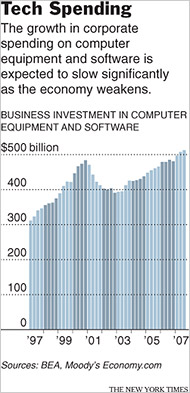 An article by Andrew McAfee triggered my interest today, what will happen to technology in a recession? Or more specifically, what technology actually excels in a recession? Some IT leaders have commented in the NY Times, but I would like to focus more specifically on software technology.
An article by Andrew McAfee triggered my interest today, what will happen to technology in a recession? Or more specifically, what technology actually excels in a recession? Some IT leaders have commented in the NY Times, but I would like to focus more specifically on software technology.
The most obvious answer is that the cheapest software wins. Deploying SAAS and other Web 2.0 models are not just about delivering new functionality; they are about driving down costs through low delivery costs and economies of scale. With employment at near record lows (and salaries at record highs, especially in IT) no-one wants to take on more staff.
 I think that the silver lining to a recession is that the weak get weaker and the strong get stronger. A renewed focus on what works and how to efficiently deliver value is a good thing for any company. With SAAS systems now gathering widespread acceptance a recession will, in my opinion, accelerate the growth of these systems. The current financial crisis has also highlighted how interconnected the world is, and SAAS systems delivered from data centres thousands of kilometres away will again gain more acceptance.
I think that the silver lining to a recession is that the weak get weaker and the strong get stronger. A renewed focus on what works and how to efficiently deliver value is a good thing for any company. With SAAS systems now gathering widespread acceptance a recession will, in my opinion, accelerate the growth of these systems. The current financial crisis has also highlighted how interconnected the world is, and SAAS systems delivered from data centres thousands of kilometres away will again gain more acceptance.
Unlike the article I don’t think it is necessarily a case of socially driven applications gaining traction, I also think CRM and ERP systems will see an increase in popularity. Customers are no longer so easily separated from their cash, and every inefficiency in the supply line is being watched like a hawk. Adopting best practice from a new technology package is a great way to address these issues.

